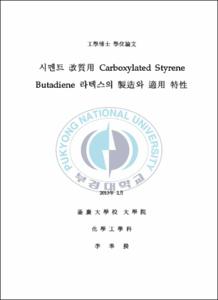시멘트 改質用 Carboxylated Styrene Butadiene 라텍스의 製造와 適用 特性
- Alternative Title
- Preparation and Application Characteristics of Carboxylated
- Abstract
- This study was attempted to develop appropriate carboxylated styrene butadiene latex for cement modifiers and to investigate the characteristics such as workability, compressive and flexural strength and durability on latex modified concrete, very-early-strength latex modified concrete and latex modified mortar when resulting latex were mixed with cement. The polymerization process of latex was performed by the method of the two-step emulsion polymerization advantageous to controlling particle size, particle size distribution and reaction time.
Some obtained results from experimental research were as followings.
The properties of latex were investigated on various styrene/butadiene monomer ratios and styrene/butadiene monomer ratio affected a little total solid content, pH, particle size, gel content and reaction time, but affected highly glass transition temperature(Tg) and viscosity. From the test results, Tg was linearly increased with an increase in styrene/ butadiene monomer ratio and Tg3.56 measured was satisfied Tg range (-24) for cement modifiers.
A study was made of the effects of carboxylic co-monomers on the polymerization stability, mechanical stability, total solid content, minimizing coagulation, tensile strength and curing time when prepared latex were mixed with cement. The experimental result showed that it was adequate to select in methyl methacrylate, methacrylic acid and acrylic acid with concentration of 5, 1, 1 phm, respectively as carboxylic co-monomer.
To determine the categories and concentrations for anionic emulsifiers we were performed the experiment on polymerization stability, total solid content, gel content and miscibility when latex were mixed to cement. Sodium dodecylbenzene sulfonate 0.3 phm and sodium salt of lauryl sulfate 0.5 phm were selected as anionic emulsifiers.
The experimental results showed that suitable chemicals for preparation of cement modifier were sodium monohydrogen phosphate and sodium carbonate as electrolytes, potassium persulfate and sodium bisulfite as initiators, t-dodecyl mercaptan as molecular weight control agent, and divinyl benzene as crosslink agent.
We could suggested the typical polymerization recipe for preparation of latex applicable for cement modifier from the experimental researches on the effects of styrene/butadiene monomer ratios, carboxylic co- monomer and additive chemicals. Also, it was recognized that resulted latex could satisfied the quality standards.
The prepared latex were tested for the physical and mechanical properties when it was applied to cement modifiers. The test results were recognized that latex modified concrete and very-early-strength latex modified concrete were exhibited higher improvement in compressive strength, flexural strength, workability and durability evaluation at optimum mixing ratio P/C=15 wt%.
Finally, from the application experiment of latex modified mortar, it was identified that sand/cemet=11.25 was optimum mixing ratios and compressive, flexural and adhesive strength were exhibited remarkable improvement at polymer/cement=20 wt%, water/cement=47 wt% and curing period=24 h.
- Issued Date
- 2013
- Awarded Date
- 2013. 2
- Type
- Dissertation
- Publisher
- 부경대학교
- Affiliation
- 부경대학교 대학원
- Department
- 대학원 화학공학과
- Advisor
- 주창식
- Table Of Contents
- 목 차 ⅰ
List of tables ⅵ
List of figures ⅷ
1. 서 론 1
2. 이 론 8
2.1. 유화중합의 특징 8
2.2. 유화중합의 반응 매카니즘 9
2.2.1. 단량체로 팽윤된 유화제 미셀 개시반응설 9
2.2.1.1. Harkins model 10
2.2.1.2. Smith-Ewart 반응속도론 15
2.2.2. 흡착된 유화제 층 개시설 20
2.2.3. 수용액상 개시설 20
2.2.4. 단량체 액적 개시설 20
2.3. 이단계 유화중합 21
2.4. 폴리머-시멘트 Co-matrix 형성 매카니즘 22
3. 실 험 25
3.1. 라텍스의 제조 25
3.1.1. 사용 시약 25
3.1.2. 시험 재료 25
3.1.3. 실험 장치 26
3.1.4. 실험 방법 32
3.1.4.1. 일단계 유화중합(Seed latex 중합) 32
3.1.4.2. 이단계 유화중합(Base latex 중합) 33
3.2. 라텍스의 기본물성 시험 33
3.2.1. 중합수율 시험 33
3.2.2. 겔함유량 및 팽윤지수 시험 34
3.2.3. 전고형분함유량 시험 35
3.2.4. 기계적 안정성 시험 35
3.2.5. 라텍스 입경 측정 및 입자수 밀도 산출 36
3.2.6. 투과전자현미경 사진촬영(TEM) 37
3.3. 시멘트 개질 가공물성 시험 37
3.3.1. 굳지 않은 시멘트 몰타르의 물성 시험 37
3.3.1.1. 슬럼프 시험 37
3.3.1.2. 플로 시험 38
3.3.1.3. 공기량 시험 38
3.3.2. 경화된 시멘트 몰타르의 물성 시험 38
3.3.2.1. 시험 공시체의 성형 및 양생 38
3.3.2.2. 휨강도 시험 38
3.3.2.3. 압축강도 시험 39
3.3.2.4. 내구성능 시험 39
4. 결과 및 고찰 41
4.1. 실험 중합처방의 제안 41
4.2. 유리전이온도의 주 단량체 비 의존성 41
4.3. 친수성 공단량체의 영향 48
4.4. 유화제의 영향 55
4.4.1. 음이온성 유화제의 선정 55
4.4.2. 비이온성 유화제와 라텍스의 안정화 56
4.5. 전해질의 영향 59
4.5.1. 전해질의 선정 59
4.5.2. 전해질 농도의 영향 60
4.6. 개시제의 영향 65
4.6.1. 개시제의 선택 65
4.6.2. 개시제 농도의 영향 65
4.7. 분자량 조절제와 가교제의 영향 67
4.8. 표준중합처방의 제시 71
4.9. 라텍스 중합 71
4.9.1. Seed latex 중합 71
4.9.2. 이단계 유화중합에 의한 라텍스 중합 75
4.10. 라텍스의 시멘트 개질재 적용 특성 81
4.10.1. 품질 기준 81
4.10.2. LMC 적용 특성 85
4.10.2.1. 압축강도에 미치는 혼화량의 영향 85
4.10.2.2. 휨강도에 미치는 혼화량의 영향 88
4.10.2.3. LMC의 내구성 평가 92
4.10.2.3.1. LMC의 작업성 평가 92
4.10.2.3.2. 길이변화 시험 93
4.10.2.3.3. 동결융해 저항성 시험 94
4.10.2.3.4. 염화물이온 투과성 평가 94
4.10.2.3.5. 박리 저항성 시험 95
4.10.2.3.6. 염분 침투깊이 96
4.10.2.3.7. 중성화 저항성 96
4.10.3. VES-LMC 적용 특성 97
4.10.3.1. 압축강도에 미치는 혼화량의 영향 97
4.10.3.2. 휨강도에 미치는 혼화량의 영향 99
4.10.4. LMM 적용 특성 102
4.10.4.1. 강도와 작업성에 미치는 S/C 비의 영향 102
4.10.4.2. LMM의 강도와 내구성 평가 104
5. 결 론 110
References 112
- Degree
- Doctor
- Files in This Item:
-
-
Download
 시멘트 改質用 Carboxylated Styrene Butadiene 라텍스의 製造와 適用 特性.pdf
기타 데이터 / 1.98 MB / Adobe PDF
시멘트 改質用 Carboxylated Styrene Butadiene 라텍스의 製造와 適用 特性.pdf
기타 데이터 / 1.98 MB / Adobe PDF
-
Items in Repository are protected by copyright, with all rights reserved, unless otherwise indicated.